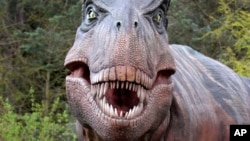Paleontologists have unearthed the fossilized remains of a pygmy Tyrannosaurus rex in northern Alaska. The prehistoric creature, which roamed the Arctic some 70 million years ago during the late Cretaceous period, was about half the size of its fearsome first cousin farther to the south.
Most cars weigh more than Nanuqsaurus, whose name means “polar bear lizard” in the Alaskan Inupiat language.
When fully grown, scientists estimate the size of the dinosaur formally known as Nanuqsaurus hoglundi to have been around six meters long, weighing a mere 450 kilograms. Paleontologists say the pygmy T. rex was the spitting image of its enormous first cousin, the giant tyrannosaur, which was twice the size of Nanuqsaurus.
A skull section and upper and lower jaw bones belonging to the pygmy T. rex were discovered by paleontologists with the Perot Museum in Dallas, Texas in the southeastern U.S. They found fossils of the mini tyrannosaur while unearthing the remains of another previously unknown, tiny, horned dinosaur.
Anthony Fiorillo spotted the bones of Nanuqsaurus in a four-by-four meter excavation site in the Prince Creek Formation in Alaska’s North Slope above the Arctic Circle.
“I am absolutely thrilled by this discovery. And the fact that we found not one, but two brand new animals in the very same hole in the ground is absolutely mind-boggling to me,” he said.
The discovery of Nanuqsaurus did not come as a total surprise to paleontologists. They had suspected the existence of a carnivorous predator in the Arctic because of teeth marks on the bones of the horned dinosaur, which was probably a rare treat for the pygmy T. Rex.
Matt Lamanna is assistant curator of vertebrate paleontology at the Carnegie Museum of Natural History in Pittsburgh, Pennsylvania. Because the Arctic region is cloaked in darkness for half the year, Lamanna says there probably was not much for the tiny Nanuqsaurus to eat.
“There was evolutionary pressure on it to develop small size because the environment it was living in probably would have had less food, consistently available food, than environments further south that were far less seasonal that ... didn’t have long periods of darkness and long periods of light,” said Lamanna.
Experts say Nanuqsaurus was not the only prehistoric animal that adapted to isolated environments; on a remote Russian Arctic coast island, mammoths the size of cows wandered around.
Anthony Fiorillo and colleagues describe their discovery of the pygmy Tyrannosaur in the journal PLoS ONE.
Most cars weigh more than Nanuqsaurus, whose name means “polar bear lizard” in the Alaskan Inupiat language.
When fully grown, scientists estimate the size of the dinosaur formally known as Nanuqsaurus hoglundi to have been around six meters long, weighing a mere 450 kilograms. Paleontologists say the pygmy T. rex was the spitting image of its enormous first cousin, the giant tyrannosaur, which was twice the size of Nanuqsaurus.
A skull section and upper and lower jaw bones belonging to the pygmy T. rex were discovered by paleontologists with the Perot Museum in Dallas, Texas in the southeastern U.S. They found fossils of the mini tyrannosaur while unearthing the remains of another previously unknown, tiny, horned dinosaur.
Anthony Fiorillo spotted the bones of Nanuqsaurus in a four-by-four meter excavation site in the Prince Creek Formation in Alaska’s North Slope above the Arctic Circle.
“I am absolutely thrilled by this discovery. And the fact that we found not one, but two brand new animals in the very same hole in the ground is absolutely mind-boggling to me,” he said.
The discovery of Nanuqsaurus did not come as a total surprise to paleontologists. They had suspected the existence of a carnivorous predator in the Arctic because of teeth marks on the bones of the horned dinosaur, which was probably a rare treat for the pygmy T. Rex.
Matt Lamanna is assistant curator of vertebrate paleontology at the Carnegie Museum of Natural History in Pittsburgh, Pennsylvania. Because the Arctic region is cloaked in darkness for half the year, Lamanna says there probably was not much for the tiny Nanuqsaurus to eat.
“There was evolutionary pressure on it to develop small size because the environment it was living in probably would have had less food, consistently available food, than environments further south that were far less seasonal that ... didn’t have long periods of darkness and long periods of light,” said Lamanna.
Experts say Nanuqsaurus was not the only prehistoric animal that adapted to isolated environments; on a remote Russian Arctic coast island, mammoths the size of cows wandered around.
Anthony Fiorillo and colleagues describe their discovery of the pygmy Tyrannosaur in the journal PLoS ONE.





